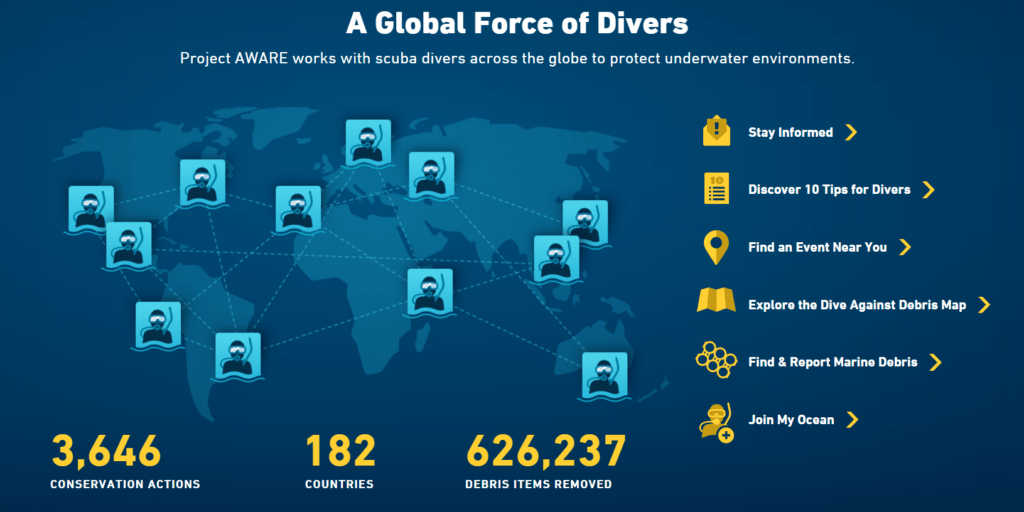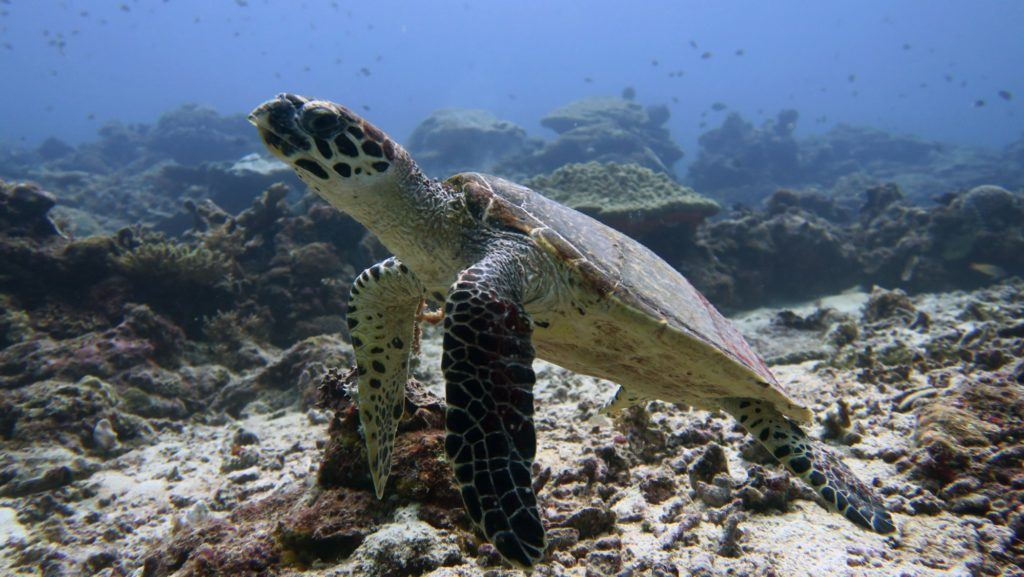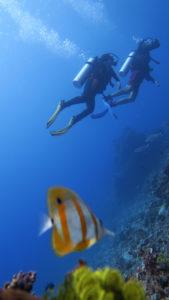PADI and Climate Change: Staying Afloat or Drowning?

Will marine life and coral reefs survive climate change? Are scuba divers helping or hurting?
The advent of a self-contained underwater breathing apparatus (SCUBA) made the natural wonders of the underwater world accessible to people. Today, scuba diving is one of the world’s fastest growing recreational sports, representing a multi-billion-dollar industry. [1] PADI, the Professional Association of Diving Instructors, certifies divers and instructors globally, representing 60% of dive operators across 180 countries. PADI certified divers grew from 2.5 million in 1988 to 17.5 million in 2008. [1] [2]
Climate change and scuba diving
It is nearly impossible to decouple the recreational scuba diving industry from the natural underwater environments enjoyed by divers. Any environmental damage or impact to coral reefs and/or marine life from climate change will have a direct and potentially catastrophic impact on scuba diving. Climate change is linked to rising sea levels, increased incidence of extreme weather events, and higher acid levels in the sea as a result of rising ocean temperatures by 1.3 degrees Fahrenheit. [3] Each of these consequences of climate change are likely to have negative effects on reefs, marine life, and ultimately scuba diving. For example, extreme weather events, such as the 2004 tsunami in Thailand, cause dive operators to lose short-term business and less desirable diving conditions longer-term. [4] Though individual weather events cannot be directly attributed to climate change, scientists predict there will be more such events in the future. Furthermore, man-made environmental threats such as coral breakage and pollution put further strain on coral reefs, making them more vulnerable to effects of climate change. [5] By 2050, some scientists predict that reefs could be completely extinct. [3]
Not only is scuba diving impacted by climate change, but the industry itself contributes to the problem. Avid scuba divers will travel far distances to ‘must-see’ dive spots: Australia’s Great Barrier Reef, the Maldives, Fiji, Egypt, to name a few. Given the majority of PADI certified divers are registered in western countries, long-haul flights are required to reach these destinations. Once you factor in carbon emissions generated during these flights, plus the extra luggage weight to carry scuba equipment, on a per-diver basis, diving tourism accounts for an unsustainable level of greenhouse gas emissions before the diving even begins. [2]
PADI’s role
PADI relies on a growing number of certified divers and dive operators to maintain a successful business. The concerns raised by climate change pose a threat to future demand for scuba diving if the quality of dive sites is compromised. PADI has recognized and attempted to address these concerns, but there are definitely additional opportunities to improve the long-term prospects of scuba diving in light of climate change. PADI has incorporated environmental awareness into its educational materials used for various certifications, but stops short of educating divers on climate change impacts. [2] PADI also founded Project AWARE, a non-profit organization bringing together volunteer divers to help protect coral reefs and marine habitats. [6] These initiatives are consistent with research that has found operators are much more focused mitigating on shorter-term man-made environmental concerns rather than attacking impending climate change. [4]
Project AWARE

Going forward, PADI should find ways to incorporate climate change risks and mitigants to round out its mandatory certification educational materials. Furthermore, PADI should find additional ways to assert influence and control over the individual dive operators to ensure they and their divers are adhering to the lowest environmental impact practices. Finally, PADI has not addressed the potential challenges that could arise if carbon taxes are imposed by certain governments or globally; such a tax could deter divers from taking long-haul flights to reach attractive dive sites. Though there is not an easy solution to this potential issue, PADI should begin to think about alternatives such as creating additional artificial reefs that are more accessible to divers from western countries.
—
The future of scuba diving is at risk if PADI and associated dive operators do not begin to address the impacts of climate change specifically. It might be too late to reverse the damage that has already been done in the past several decades, but there is still time to preserve marine ecosystems and prepare for the impacts of climate change on dive sites and dive tourism as a broader industry.
[Word count: 696]
Sources:
- Ghazali Musa and Kay Dimmock “Scuba Diving Tourism: Introduction to Special Issue,” Tourism in Marine Environments: Special Issue, vol. 8, no. 1-2, 2012, pp. 1-3.
- Brian Garrod and Stefan Gössling, New Frontiers in Marine Tourism: Diving Experiences, Sustainability, Management (Routledge, 2007), pp. 115-132.
- Rebecca M. Henderson, Sophus A. Reinert, Polina Dekhtyar and Amram Migdal, “Climate Change in 2016: Implications for Business,” HBS N2-317-032 (Boston: Harvard Business School Publishing, 2016), pp. 3-5.
- Kevin C. Hillmer-Pegram, “Understanding the resilience of dive tourism to complex change,” Tourism Geographies: An International Journal of Tourism Space, Place and Environment, 2014.
- Andrew L. Jones, Michael R. Phillips, and M. Phillips, eds., Disappearing Destinations: Climate Change and Future Challenges for Coastal Tourism (CAB International, 2009), p. 148.
- Project AWARE homepage, http://www.projectaware.org/, accessed November 2016.
Image sources:
- Fisheye Underwater Productions (professional photos taken during a dive in El Nido, Philippines)
- Project AWARE homepage, http://www.projectaware.org/, accessed November 2016.





This article brings up an interesting point around diving tourism and the impacts of the carbon emissions required to reach certain destinations. As a PADI diver myself, I’ve seen the Project AWARE materials as well as the various initiatives that PADI spearheads on a monthly basis. Much of the literature focuses on getting people ‘into the field’ in order to collect garbage and clean up the oceans, but in order to do this, some level of travel is required for most of the PADI-certified population. Furthermore, PADI often does dive spot “highlights” and encourages divers to visit these scenic destinations. Do you think that the benefits of these programs outweigh the costs? Does this type of material shed more awareness on the risks of climate change, or does it encourage tourism without additional thought?
While I agree that a lot more can be done in the educational materials to inform people of the threats of climate change, I also think there is an inherent tension between recreational scuba diving and environmental preservation in general. Artificial reefs may stem part of the issue, but I think for most divers, there’s nothing like seeing a real natural wonder up close.
I love this post. In talking about climate change, it is easiest to focus on impacts on people, land, or sea levels as a whole; it is hard to remember that there is a whole ecosystem under the sea that is extremely vulnerable to this trend.
I agree that extensive travel contributes to the problem, and that ideally we should all be more conscious of the environmental impact of recreational activities. But given that education is a huge barrier to all behavior change, isn’t it better that we know more about the world we live in to be inspired to help protect it, and share that passion with others? I think this relates to the debate about zoo’s, which are controversial in keeping animals in enclosed and in varying degrees of habitat quality. On the other hand, is it better that millions of children and families who visit them gain an appreciation for the natural world?
I’m not convinced what the right answer is to these questions. But in the meantime, I think your recommendations are spot on: if PADI, operators, and divers can become more aware, we can become part of the solution instead of part of the problem.
A Scuba Diver,
As an avid fellow PADI certified scuba diver, I could not agree more that more needs to be done for awareness and preservation of these beautiful natural ecosystems. I am guilty of being one such diver you speak about in your article that lugs heavy equipment half way across the world. Admittedly, I have overlooked the negative impact these actions ironically stem from my good intentions. I appreciate you shedding light on the subject and issue at hand; I will most definitely think twice about renting equipment on all future dive trips.
One question I found myself pondering from reading your blog, what are a few specific examples of how PADI’s Project AWARE is taking on this challenge?
As a certified diver, I wanted to thank you for this article that shines a new light on the practice of scuba diving. I have been diving with PADI for years and am always amazed by how they consistently and growingly insist on the need for scuba diving to weave in the demands of sustainability. Yet, I agree that their activity carbon emissions are mostly tied to the travels needed for divers to go the sites. It appears to me that it is actually a lever that they do not control.
This article brings up some very interesting points. Ocean acidification and rising sea levels are starting to have a dramatic impact on the ecosystems beneath the water. While I agree that most of the carbon impact comes from the travel to the scuba locations, I wonder about the long term implications of carbon taxes to prevent more individuals from traveling to locations. For instance, will this lead more individuals to evade the legal and regulatory structures and still scuba in the Great Barrier Reef? In doing so, could the lack of oversight cause more damage to the already delicate ecosystem? Further, would scuba divers be interested in exploring artificial environments?
Awesome post! This is a huge issue, and I enjoyed reading your thoughts on it.
As you mentioned, artificial reefs are an effective–albeit temporary–replacement for natural reefs. Previous commenters mentioned a concern about whether artificial reefs will serve as adequate tourist destinations. I’d encourage everyone to read about the U.S.S. Oriskany (check out this NY Times article: http://www.nytimes.com/2008/08/19/science/earth/19ship.html), also known as the “Great Carrier Reef.” Intentionally sinking decommissioned naval vessels in specific, targeted locations provides 1) a great home for marine life and 2) an excellent tourist destination for wreck-certified divers.
It would be great to see the diving community to continue to build support for the creation of artificial reefs–both for wildlife and the diving industry.
Great post! It’s a shame that human activity has damaged the beauty of the our world beneath sea level.
I agree that PADI should find additional ways to assert influence and control over the individual dive operators but what about the divers who don’t dive with an operator? How can PADI effectively enforce the sustainability rules on 17.5M certified divers? Also, I commend the creativity of your idea to create artificial reefs but wouldn’t this be counter productive to our climate change goals given that we’d effectively be driving more divers (and their carbon footprints) to our reef?